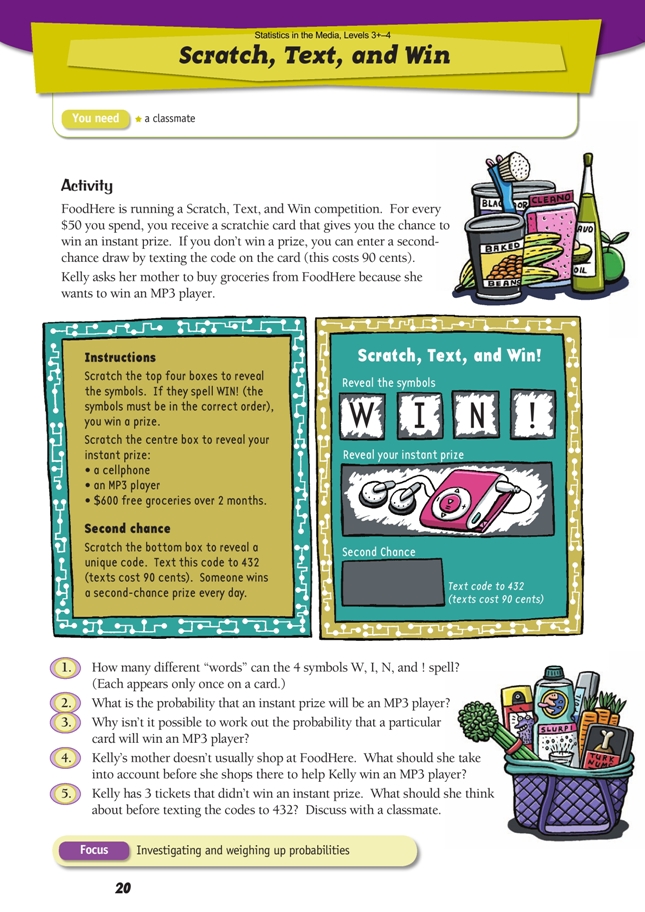This is a level 4 statistics activity from the Figure It Out series.
A PDF of the student activity is included.
Click on the image to enlarge it. Click again to close. Download PDF (1246 KB)
calculate probabilities
This diagram shows the areas of Statistics involved in this activity.
The bottom half of the diagram represents the 5 stages of the PPDAC (Problem, Plan, Data, Analysis, Conclusion) statistics investigation cycle.
Statistical Ideas
Scratch, Text, and Win involves calculating probability.
A classmate
For question 1, students may need to list every “word” that can be spelt with these letters. Encourage them to do this in a systematic way, as shown in the Answers. There are 4 different letters that can go in the first box, then 3 remaining letters that can go in the second box, leaving two possible letters for the third box and only one for the last box, so 4 x 3 x 2 x 1 = 24. (This is can be written as 4! or 4 factorial.) Alternatively, there are 6 ways to begin with a W, so there will be 6 ways to begin with every other letter (or symbol), hence 6 x 4 = 24 combinations. Note: If each letter could appear more than once, there would be 256 combinations (4 x 4 x 4 x 4).
Questions 2 and 3 deal with probability. Probability is expressed most simply as a fraction: the number of successful outcomes out of the number of possible outcomes. If either of these numbers is unknown, the theoretical probability cannot be calculated. If all the letters and prizes in this instance were equally distributed, there would be 1 chance in 72 of winning the MP3 player because 1 in 24 would win a prize and 1 in 3 prizes would be an MP3 (24 x 3 = 72).
However, we have no reason to assume the equal distribution. Before the students answer questions 4 and 5, you could discuss with them why manufacturers or businesses have competitions such as these (for example, to increase sales or to entice consumers to change to their brand over that of a competitor). Students may not understand how unlikely they are to win prizes in such competitions (see the extension activity) and may therefore be susceptible to buying goods that they don’t really need.
Extension
You could explore the likelihood of winning Lotto by giving the students Lotto numbers as a reward system in the class. At the end of each week, have a draw. Students may be very surprised to see that usually no one wins anything. Often their experiences of lotteries or raffles involve only students in their class or school. In such cases, someone always wins, and this reinforces the idea that lotteries are “easy” to win.
Answers to Activity
1. You can spell 24 different “words”, for example, WIN!, WI!N, WN!I, WNI!, W!NI, W!IN, and so on (4 x 6 = 24, four starting “letters” each having the six combinations, or 4! = 4 x 3 x 2 x 1 = 24).
2. There is no way of knowing because you are not told how many of each prize there are. (If there were equal numbers of each prize, the probability would be .)
3. You are not told how many prizes are being given away or the number of cards being distributed.
4. Answers will vary. It may cost her more money overall for her groceries than it does at her normal shop; it may cost her more money in petrol to get there. And she may not win an MP3 for Kelly no matter how many times she shops there!
5. It will cost Kelly 90 cents every time she texts a code in. She might be better off putting this money aside to save towards an MP3 player. Kelly doesn’t know what the second-chance prizes are – if she wins one, she may get something that she doesn’t even like. If everyone who gets a non-prize card texted their code in, the probability of winning a second chance prize would be low.
Key Competencies
Scratch, Text, and Win can be used to develop these key competencies:
• thinking: dealing with uncertainty and variations, evaluating, predicting or envisioning
outcomes
• using language, symbols, and texts: interpreting word problems.

